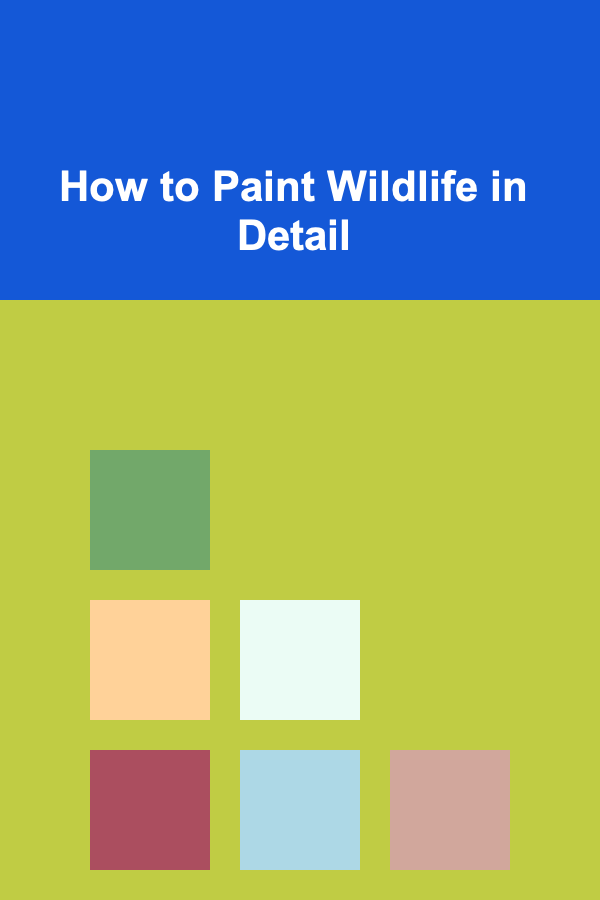
How to Paint Wildlife in Detail
ebook include PDF & Audio bundle (Micro Guide)
$12.99$11.99
Limited Time Offer! Order within the next:

Painting wildlife is a beautiful and intricate process that requires not only technical skill but also a deep connection to the subject matter. The complexity of the natural world, with its diverse species, textures, and colors, can be daunting for an artist, but with patience, observation, and practice, anyone can create detailed and lifelike wildlife artwork. In this article, we will explore how to approach wildlife painting in detail, focusing on techniques, tools, and tips that can help artists bring animals to life on canvas.
Understanding Wildlife and Its Importance in Art
Wildlife painting has been a part of artistic tradition for centuries. From the ancient cave paintings of animals to the works of contemporary wildlife artists, animals have always been a subject of fascination and inspiration. However, wildlife painting is not just about replicating the form of the animal; it's about capturing its essence, behavior, and natural environment.
When we paint wildlife in detail, we are not only documenting the species but also connecting with nature. This type of artwork often carries a message about the importance of conservation and the need to preserve our planet's biodiversity. Whether it's the majestic beauty of a lion in the savannah or the delicate wings of a butterfly in a meadow, wildlife painting can evoke emotions and inspire appreciation for the natural world.
Before you begin painting wildlife in detail, it's crucial to understand the animal's anatomy, behavior, and the environment it lives in. These factors will inform your painting style, composition, and color choices. Observation is key---spending time in nature or studying photographs and videos of the animal in its natural habitat will help you portray the subject accurately and artistically.
Essential Materials for Wildlife Painting
Choosing the right materials is crucial to achieving the level of detail you want in your wildlife painting. Depending on your preferred medium, the materials you use will vary. Below is a breakdown of some of the essential materials for both oil and watercolor wildlife painting.
1. Oil Painting Supplies
Oil paints are one of the most popular mediums for wildlife painting due to their rich colors and ability to create realistic textures. Here's a list of essential supplies for oil painting:
- Oil Paints: Choose a high-quality brand with a range of colors. Some must-have colors for wildlife painting include earth tones (e.g., burnt umber, raw sienna), various shades of greens, blues, and whites, and specific animal-related colors like ochre or ochre yellow for fur and feathers.
- Brushes: A variety of brushes will help you achieve different textures. Use flat, round, and filbert brushes in various sizes. For fine details, consider using a rigger brush or small round brushes.
- Palette: A flat palette or palette paper will allow you to mix your paints. Using a glass palette can provide a smooth surface for mixing.
- Mediums: A good medium such as linseed oil can help with paint flow and blending.
- Canvas: Stretched linen or cotton canvas works well for oil painting. Make sure it's pre-primed so that the paint adheres properly.
2. Watercolor Painting Supplies
Watercolor painting offers a lighter, more fluid approach to wildlife art, often used for softer or atmospheric renderings. Here's what you'll need:
- Watercolor Paints: Choose professional-grade watercolors for the best pigments. Some essential colors include sepia, ochre, burnt sienna, and various shades of green and blue.
- Brushes: Watercolor brushes come in various shapes, but the most useful are round brushes (for detail) and flat brushes (for washes).
- Watercolor Paper: Use high-quality, cold-pressed watercolor paper that can absorb water without warping. 300gsm paper is a good choice for detailed work.
- Palette: A watercolor palette will help you mix your colors, with wells for water and pigment.
- Water and Sponges: Always have fresh water available for diluting your paints, and a sponge to blot off excess water.
3. Other Useful Tools
- Graphite Pencils: For sketching and outlining the basic shape of the animal before you begin painting.
- Erasers: A kneaded eraser can gently remove unwanted pencil lines and lighten areas of the painting if necessary.
- Palette Knives: Used for mixing paint, scraping, or creating texture on the canvas.
- Varnish: If you're working in oils, a varnish can protect the final painting once it's dry.
Techniques for Painting Wildlife in Detail
Once you've selected your materials, it's time to dive into the actual process of painting. Here are the essential techniques to focus on when painting wildlife in detail.
1. Observation and Reference Materials
Before you start painting, you need to observe the animal you are going to paint. This is where the skill of detailed wildlife painting truly begins. Whether you're working from real life or photographs, your reference materials will help guide you through every step of the process.
Spend time observing the animal in its natural habitat, if possible. Pay attention to its movements, how it interacts with its environment, and its unique features. If real-life observation is not an option, use high-quality photographs or videos. These will allow you to capture details like fur texture, feather patterns, and subtle variations in skin tones.
2. Sketching the Basic Form
Start by sketching the basic form of the animal with a light pencil (H or 2H). This sketch should focus on the proportions, pose, and structure of the animal. Don't worry about details at this stage---just get the overall shape right.
For more complex compositions, consider breaking down the animal into simple shapes such as ovals for the body, circles for the head, and elongated shapes for limbs. This will help with the accuracy of the final painting.
3. Underpainting and Blocking in Color
For oil painters, underpainting is an essential step. This is a monochromatic layer that sets the foundation for your final painting. Use a neutral color (such as burnt umber or raw sienna) to block in the main shapes and shadows. The underpainting helps establish the tonal values and serves as a guide for layering subsequent paint.
Watercolor artists often use a similar technique called "wet-on-dry" where you lightly paint in broad, general areas of color before adding finer details.
4. Layering and Building Up Details
Once your underpainting is complete, you can begin layering the paint to build up the details. Both oil and watercolor painters use layering techniques to gradually add more detail. The goal is to work from general shapes and values to more specific textures and colors.
- In oil painting, start with a thin layer of paint and gradually build up thicker layers. Oil paint takes longer to dry, which gives you more time to work and blend. Use a glazing technique to create transparency and depth in areas such as fur and feathers.
- In watercolor painting, you will work with thin washes of paint and gradually build up layers to achieve depth. Watercolor dries lighter than it appears when wet, so you'll need to layer colors to achieve the desired intensity. Control the amount of water you use to keep the pigment concentrated for fine details.
5. Fur and Feather Detail
Painting fur and feathers is one of the most challenging aspects of wildlife painting. The key to achieving realism is to pay attention to the direction and flow of the fur or feathers. Study your reference materials closely to observe the unique patterns and textures.
- For fur, use long, fine brushstrokes to create the illusion of hair. Keep the brushstrokes light and varied to give the fur a natural, soft look. Work in layers, starting with a base color and adding highlights and shadows to define the depth and texture of the fur.
- For feathers, use short, curved strokes to mimic the delicate, overlapping structure of feathers. Paint in the direction of the feather growth, paying attention to the edges where the feathers meet. Use highlights and shadows to create the illusion of light falling on the feathers.
6. Capturing the Eyes
The eyes are often considered the most important feature of an animal in a wildlife painting. They convey emotion, personality, and life. To paint the eyes in detail, start by establishing the shape and size of the eye, then layer in the colors. Use lighter colors to add highlights to the iris and pupil, and darker tones to create depth around the eye.
7. Creating the Background
The background plays an important role in setting the scene and enhancing the subject of the painting. For wildlife art, consider the habitat of the animal and how it interacts with its environment. Whether it's a lush forest, a rocky cliff, or an open savannah, the background should complement the subject without overshadowing it.
- In oil painting, you can use glazing and blending techniques to create soft transitions in the background.
- In watercolor, use washes and gradients to suggest the environment while leaving the animal the focal point.
8. Final Touches
Once you have built up the main features of the animal and its environment, it's time to add final touches. These include refining details, adding highlights, and ensuring that the lighting in the painting is consistent. You may also need to add texture to the background or foreground to create depth and balance the composition.
Conclusion
Painting wildlife in detail is a rewarding and challenging endeavor that requires a combination of artistic skill, patience, and a deep understanding of the animals being portrayed. By focusing on observation, mastering techniques for fur, feathers, and textures, and refining your brushwork, you can create stunning wildlife art that captures the beauty and essence of the natural world. Whether working in oil or watercolor, the key to success is practice, observation, and a genuine love for the animals you are painting.
Through dedication and attention to detail, wildlife painting not only becomes a technical skill but a meaningful way to connect with nature and preserve its magnificence through art.

How to Build a Checklist for Teaching Your Child School Routines
Read More
How to Deal with Critters in Your Tent
Read More
How to Make a Checklist for Leveraging Social Media Analytics Tools
Read More
Selling the Vision: Techniques for Strategic Communications
Read More
The Future of Commuting: Innovative Public Transportation Alternatives
Read More
How to Practice Zen Meditation
Read MoreOther Products

How to Build a Checklist for Teaching Your Child School Routines
Read More
How to Deal with Critters in Your Tent
Read More
How to Make a Checklist for Leveraging Social Media Analytics Tools
Read More
Selling the Vision: Techniques for Strategic Communications
Read More
The Future of Commuting: Innovative Public Transportation Alternatives
Read More